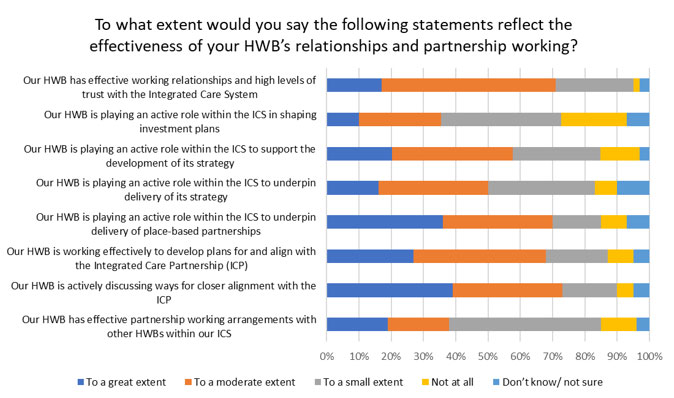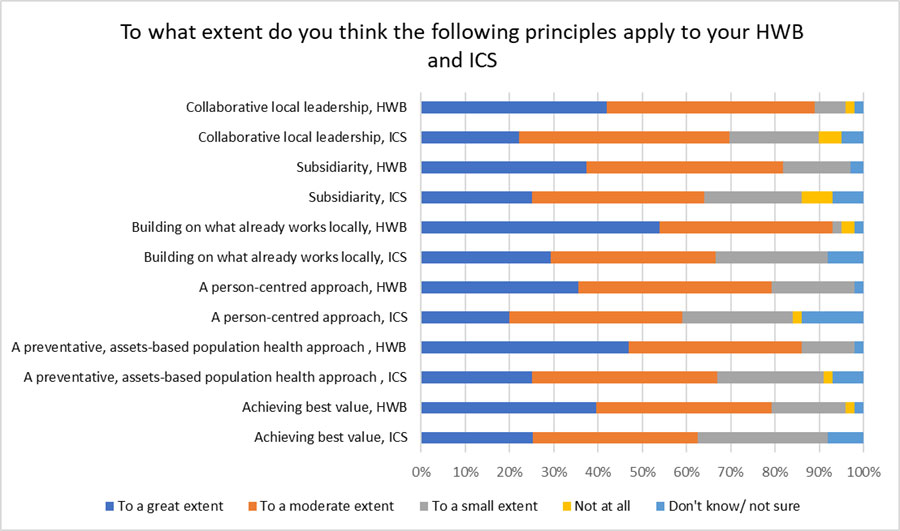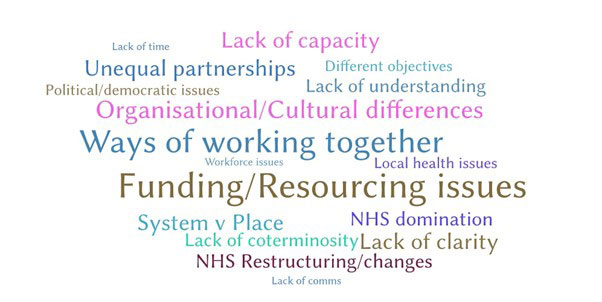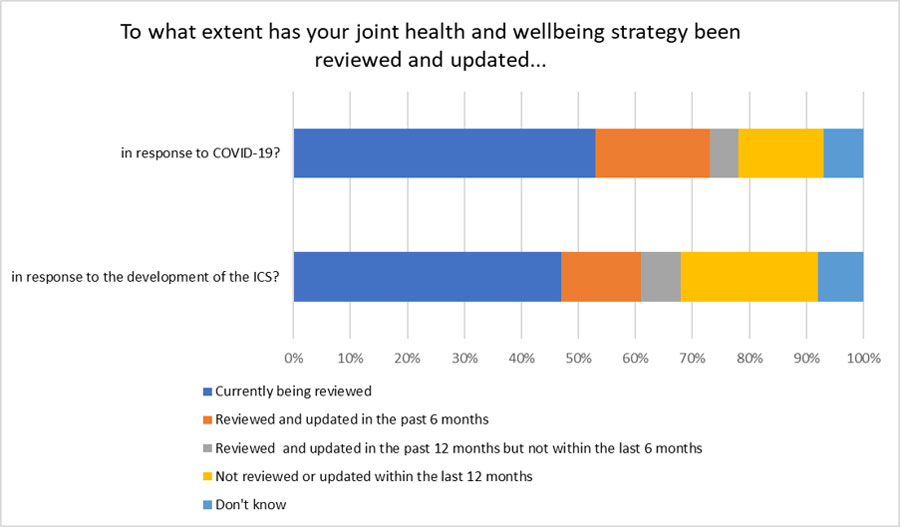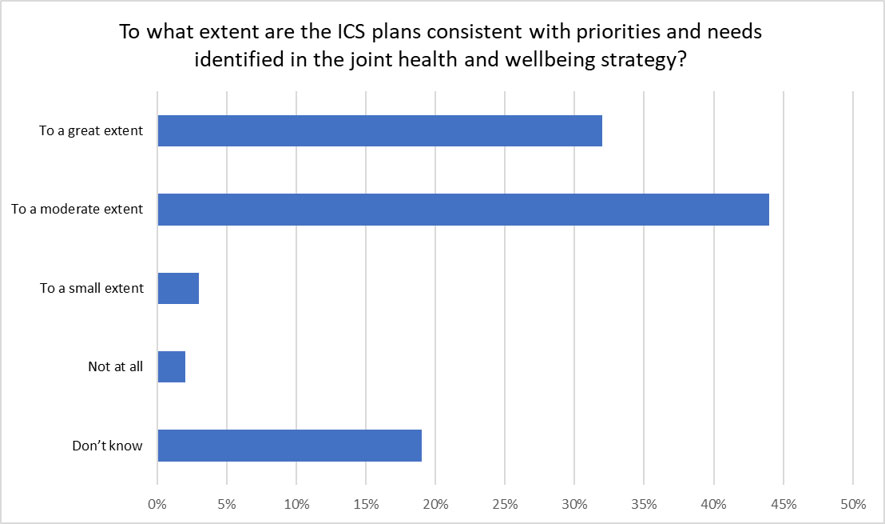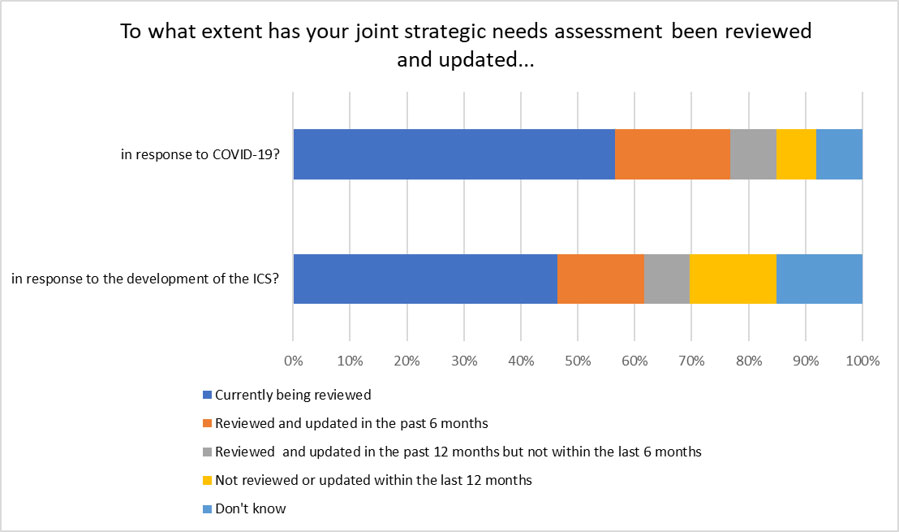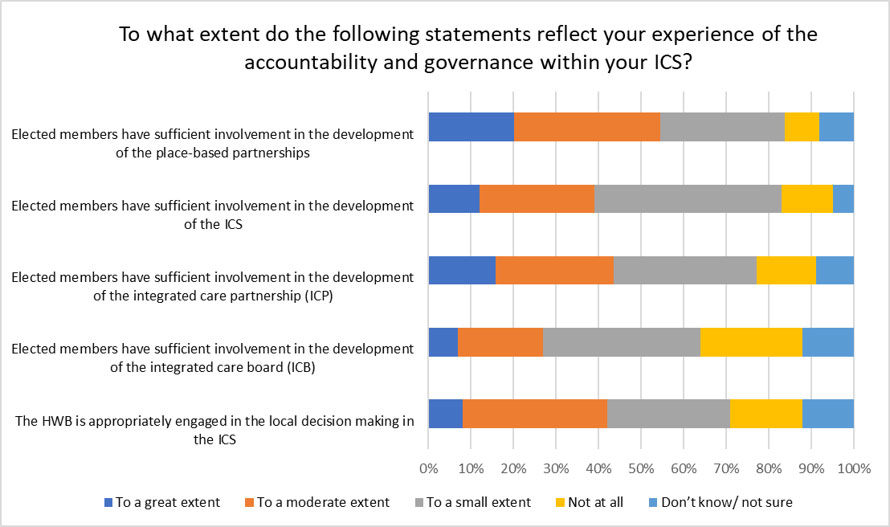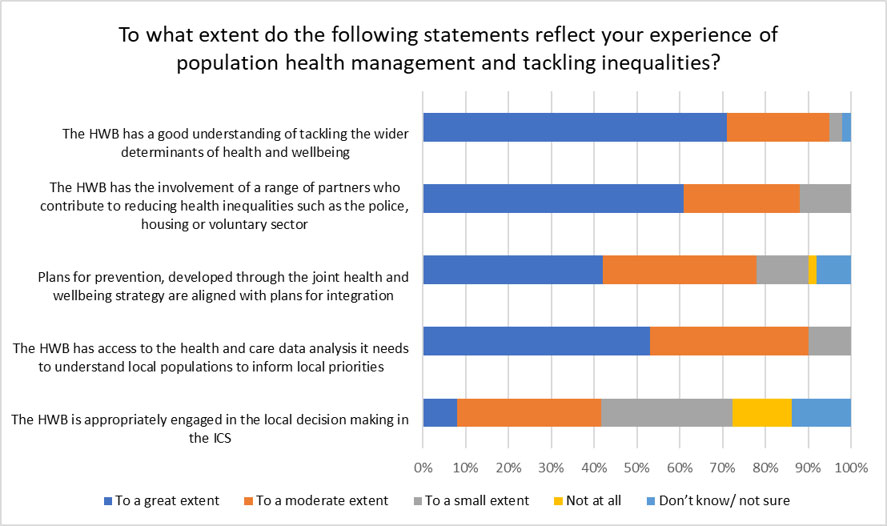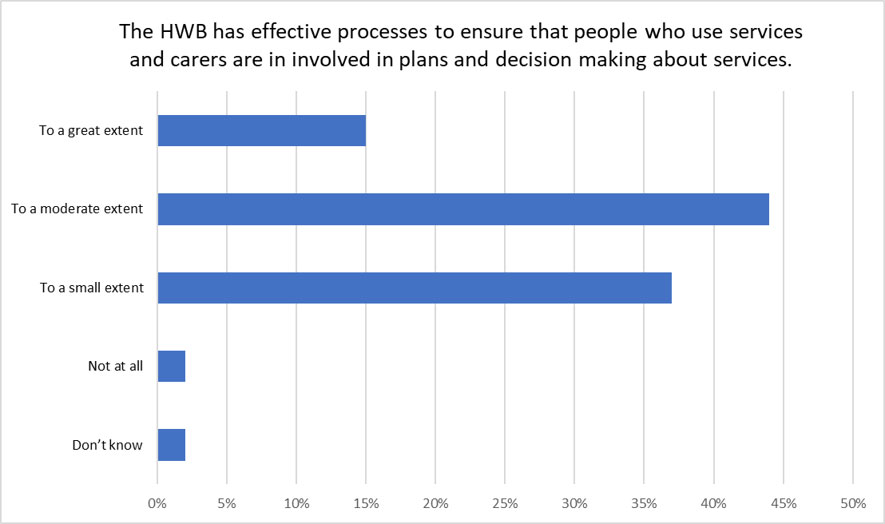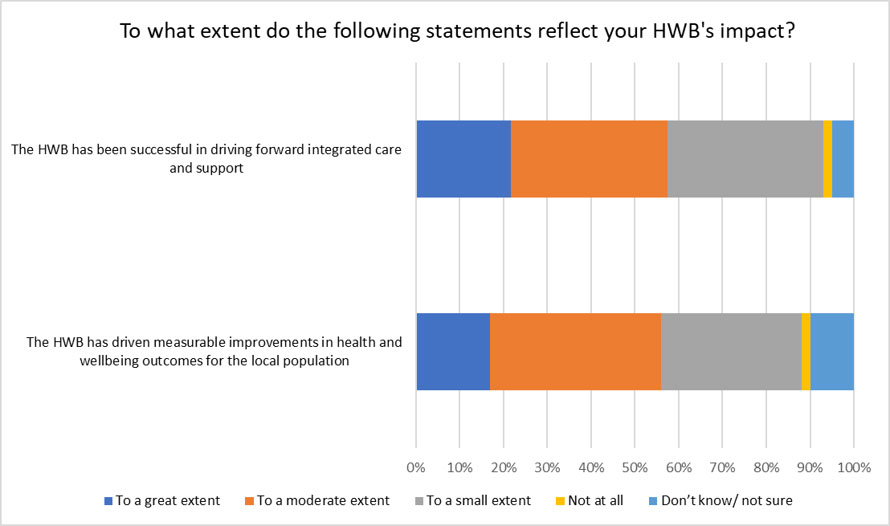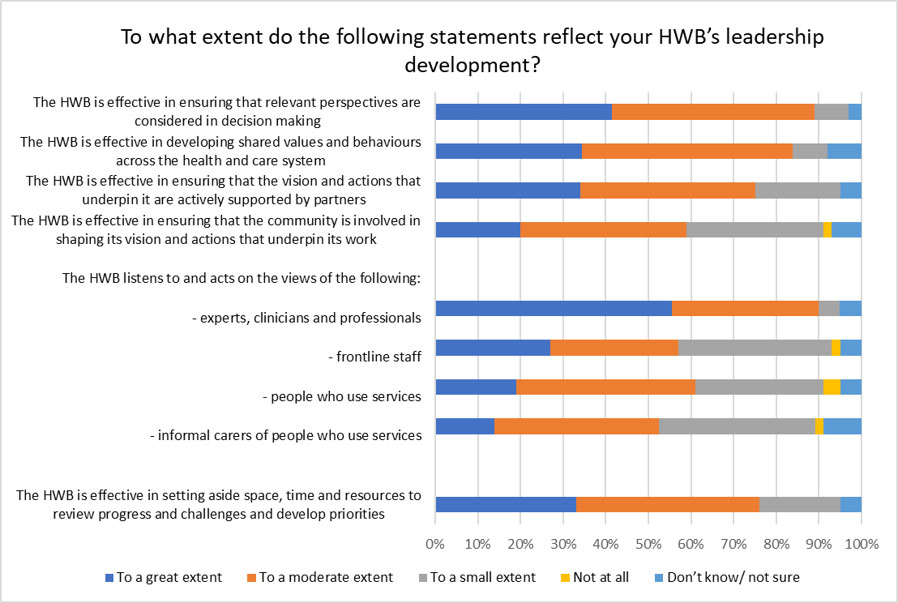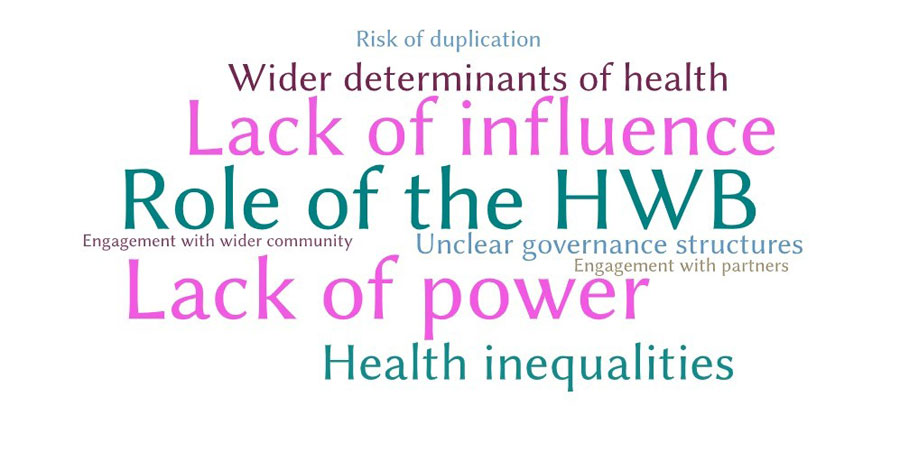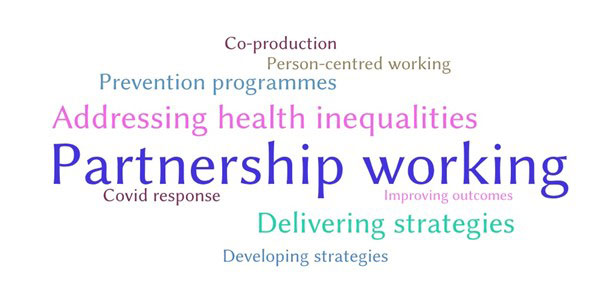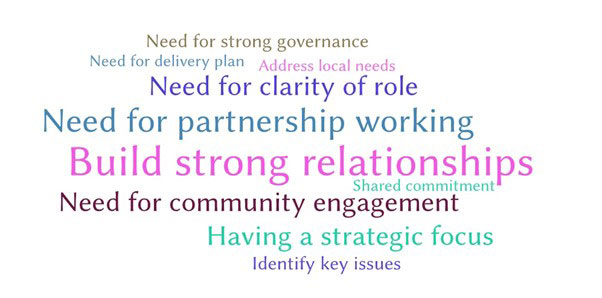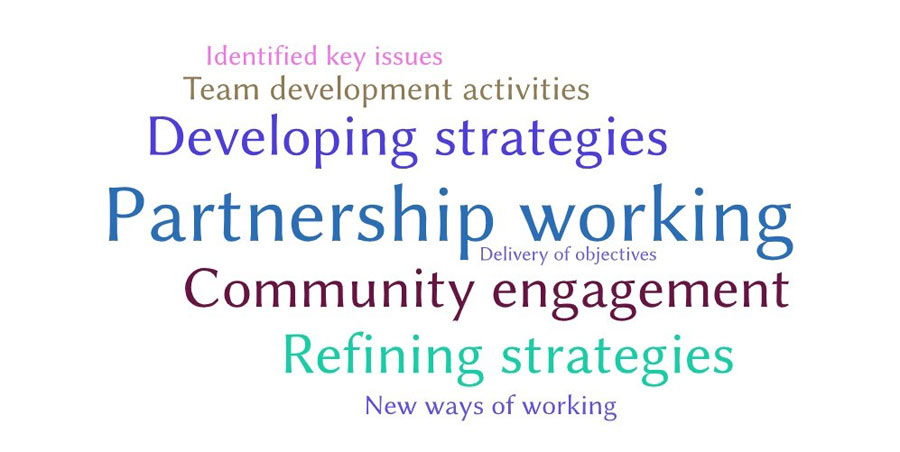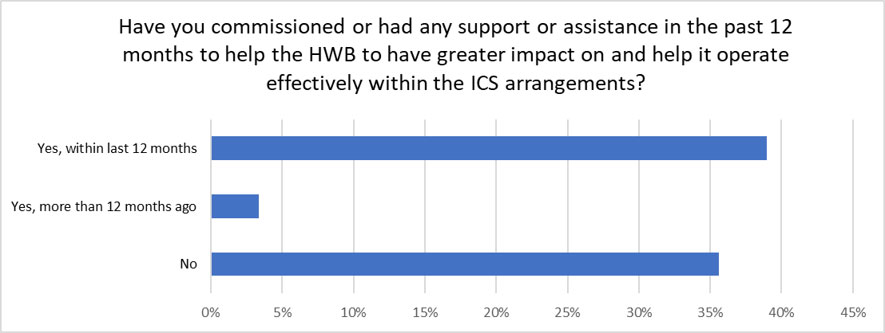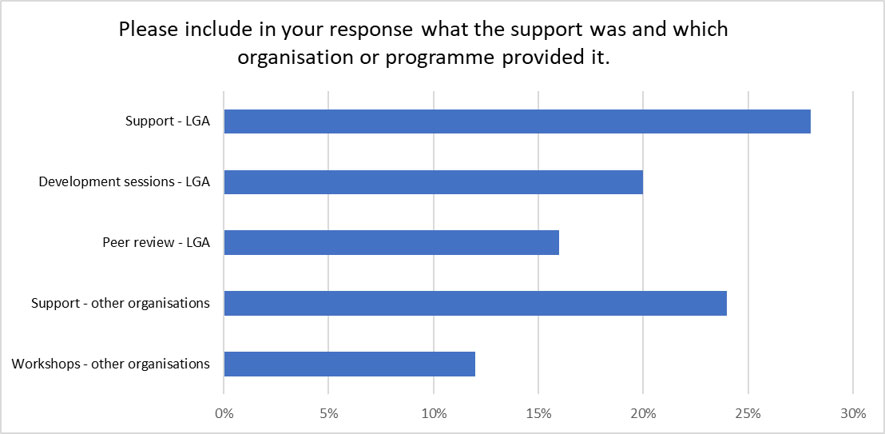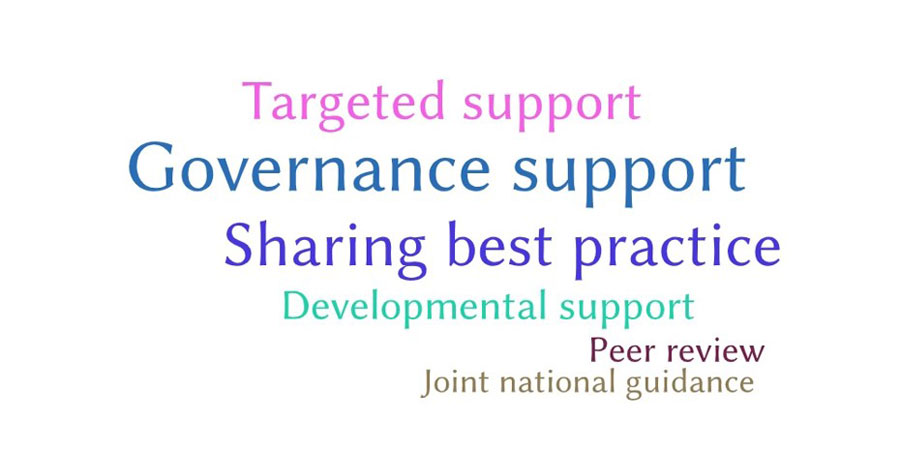Summary of findings, October – November 2021
Background and methodology
- In October 2021 Health and Wellbeing Boards (HWBs) were invited to take part in an online survey.
- The survey asked HWBs for their views on the effectiveness of relationships, partnership working and standing of your HWB within the Integrated Care System (ICS)
- The aim was to understand the extent to which ICSs are proactively engaging with HWBs and the extent to which HWBs are reaching out to ICSs to help shape the relationship between place and system leaders.
- A link to the survey form was circulated via bulletins, first magazine and emails to individuals within ICSs and HWBs
- The survey was in the field for just over seven weeks spanning October and November 2021
- A total of 59 responses were received from HWBs across all regions
Strength of relationships
In order to gauge the strength of the relationships between ICss and the HWBs within their system, the survey asked them to indicate the extent to which wthey agreed with a series of statements about their relationships.
The chart above shows the extent to which respondents agreed with statements about the relationships between ICSs and the HWBs within their system. The data shown is outlined below.
- 71 per cent of respondents reported that their HWB has effective working relationships and high levels of trust with the Integrated Care System to a great or moderate extent.
- A third (36 per cent) said they are playing an active role within the ICS in shaping investment plans to a great or moderate extent.
- 58 per cent reported playing an active role within the ICS to support the development of its strategy to a great or moderate extent.
- Half (50 per cent) are playing an active role within the ICS to underpin delivery of its strategy to a great or moderate extent.
- 69 per cent stated they are playing an active role within the ICS to underpin delivery of place-based partnerships to a great or moderate extent.
- Just over two-thirds (68 per cent) are working effectively to develop plans for and align with the Integrated Care Partnership (ICP) to a great or moderate extent.
- Almost three quarters (73 per cent) reported actively discussing ways for closer alignment with the ICP to a great or moderate extent.
- 38 per cent have effective partnership working arrangements with other HWBs within our ICS to a great or moderate extent.
Principles that help establish integrated care
Respondents were given a list of principles and asked to indicate the extent to which they thought that they applied to their HWB and ICS, their existing work and their existing work to establish integrated care.
The chart above shows the extent to which respondents thought a list of principles applied to their HWB and ICS, their existing work and their existing work to establish integrated care. The data shown is outlined below.
- Nine in ten (90 per cent) of respondents thought their HWB showed collaborative local leadership to a great or moderate extent while 69 per cent thought so for their ICS.
- Four in five (81 per cent) thought their HWB was committed to subsidiarity to a great or moderate extent, and 64 per cent felt was the case for their ICS.
- Almost all respondents (93 per cent) thought their HWB was building on what already works locally to a great or moderate extent, as did 66 per cent in relation to their ICS.
- Four-fifths of respondents (80 per cent) believed their HWB used a person-centred approach to a great or moderate extent, with 59 per cent stating their ICS used this approach.
- 86 per cent felt their HWB used a preventative, assets-based population health approach to a great or moderate extent and just over two-thirds (68 per cent) thought this was used by their ICS.
- More than three-quarters (79 per cent) indicated that their HWB was achieving best value to a great or moderate extent while 63 per cent felt their ICS was achieving it to these extents.
Building effective relationships
The survey asked respondents to identify the three main challenges they faced in building effective working relationships with their local health and care partners
The open text answers provided by respondents were grouped into broad themes, the most commonly identified challenges were funding/resourcing issues, organisational/cultural differences and ways of working together. The main themes which emerged can be seen in the word cloud below.
The word cloud above shows the frequency of themes that emerged in relation to the three main challenges faced by respondents in building effective working relationships with their local health and care partners. The main themes are funding / resourcing issues; ways of working together; organisational /cultural differences; and unequal partnerships.
Joint health and wellbeing strategies
Respondents were asked to indicate the extent to which their joint health and wellbeing strategy been reviewed and updated in response to COVID-19 and as well as in response to the development of the ICS.
The chart above shows the extent to which respondents' joint health and wellbeing strategy had been reviewed and updated in response to COVID-19 and as well as in response to the development of the ICS. The data shown is outlined in the bulletpoints below.
- More than half of respondents (53 per cent) were currently reviewing their strategy response to COVID-19 and 47 per cent were reviewing theirs in response to the development of the ICS.
- A fifth of respondents (20 per cent) had reviewed and updated their strategy in the past six months in response to COVID-19 and 14 per cent had done so in response to the development of the ICS.
- A further five per cent had reviewed and updated their strategy between six and 12 months ago in response to COVID-19 while seven per cent had done so in response to the development of the ICS.
- Fifteen per cent of respondents reported they had not reviewed or updated their strategy within the last 12 months in response to COVID-19 and 24 per cent had not reviewed or updated theirs in response to the development of the ICS within the last 12 months.r they had updated their JSNA in response to COVID-19 but almost twice as many, 15 per cent, did not know whether theirs had been reviewed in response to the development of the ICS within the last 12 months.
ICS plans
The survey asked about the extent to which the ICS plans were consistent with priorities and needs identified in the joint health and wellbeing strategy.
The chart above shows the extent to which respondents' ICS plans were consistent with priorities and needs identified in the joint health and wellbeing strategy. The data shown is outlined below.
- Three quarters of respondents (76 per cent) said that their ICS plans were consistent with priorities and needs identified in the joint health and wellbeing strategy to a great or moderate extent.
- Just 3 per cent of respondents felt that the plans were consistent with their strategy’s priorities and needs to a small extent while only 2 per cent said that they were not at all consistent with them.
- Almost one in five (19 per cent) reported they did not know whether the ICS plans were consistent with priorities and needs identified in the strategy.
Joint strategic needs assessments
Respondents were asked the extent to which their joint strategic needs assessment had been reviewed and updated in response to COVID-19 and in response to the development of the ICS.
The chart above shows the extent to which respondents' joint health and wellbeing strategy had been reviewed and updated in response to COVID-19 and as well as in response to the development of the ICS. The data shown is outlined below.
- Over half of respondents (56 per cent) reported their joint strategic needs assessment (JSNA) had been reviewed and updated in response to COVID-19 and 46 per cent said that it had been reviewed in response to the development of the ICS.
- One in five (20 per cent) said they had reviewed and updated their JSNA in the past six months response to COVID-19 and 15 per cent had done so in response to the development of the ICS.
- Eight per cent had of respondents had reviewed and updated theirs between six and 12 months ago in response to COVID-19 and the same proportion (8 per cent) had done so in response to the development of the ICS.
- Seven per cent of respondents had not reviewed or updated their JSNA within the last 12 months in response to COVID-19 while 15 per cent had not reviewed or updated it in response to the development of the ICS within the last 12 months.
- Just eight per cent didn’t know whether they had updated their JSNA in response to COVID-19 but almost twice as many, 15 per cent, did not know whether theirs had been reviewed in response to the development of the ICS within the last 12 months.
Integrated Care Systems: accountability and governance
The survey sought to gain a picture how Integrated Care Systems are working by asking respondents to say how much they agreed with a series of statements about accountability and governance within their ICS.
The chart above shows the extent to which respondents felt that statements reflected their experience of the accountability and governance within their ICS. The data shown is outlined below.
- Over half of respondents (54 per cent) felt that elected members have sufficient involvement in the development of the place-based partnerships to a great or moderate extent within their ICS.
- Two-fifths (39 per cent) said that their elected members have sufficient involvement in the development of the ICS to a great or moderate extent.
- Just over two-fifths (43 per cent) of respondents reported that elected members within their ICS have sufficient involvement in the development of the integrated care partnership (ICP) to a great or moderate extent.
- A quarter (27 per cent) said that, within their ICS, elected members have sufficient involvement in the development of the integrated care board (ICB) to a great or moderate extent.
- Their HWB is appropriately engaged in the local decision making in the ICS to a great or moderate extent, according to 42 per cent of respondents.
- Comments received in relation to accountability and governance included that the processes are still in development along with further information about respondents’ local situation.
Tackling health inequalities
To gauge the local situation in relation to population health management and tackling inequalities the survey asked respondents to indicate the extent to which their experience was reflected in a series of statements.
The chart above shows the extent to which respondents felt that statements reflected their experience of population health management and tackling inequalities. The data shown is outlined below.
- Almost all respondents (95 per cent) thought that their HWB has a good understanding of tackling the wider determinants of health and wellbeing to a great or moderate extent.
- Just under nine in ten respondents (88 per cent) reported that their HWB has the involvement of a range of partners who contribute to reducing health inequalities such as the police, housing or voluntary sector to a great or moderate extent.
- Three-quarters (78 per cent) said their plans for prevention, developed through the joint health and wellbeing strategy are aligned with plans for integration to a great or moderate extent.
- Nine-tenths (90 per cent) said that their HWB has access to the health and care data analysis it needs to understand local populations to inform local priorities to a great or moderate extent.
- Two-fifths (42 per cent) of respondents thought their HWB is appropriately engaged in the local decision making in the ICS great or moderate extent.
- The comments received in relation to population health management and tackling inequalities mostly gave information about respondents’ local situation with a few stating that their ICS was still in development.
Involving people who use services, their carers and the wider community
The survey asked about how effective HWBs are in involving people who use services and their carers and the wider community.
The chart above shows the extent to which respondents felt their HWB has effective processes to ensure that people who use services and their carers and the wider community are involved in plans and decision making about services. The data shown is outlined below.
- Three in five (59 per cent) of respondents felt that their HWB has effective processes to ensure that people who use services and carers are involved in plans and decision making about services to a great or moderate extent.
- Over a third (37 per cent) of respondents reported their HWB’s processes were effective in these areas to a small extent.
- Just two per cent thought their HWB’s processes were not effective in ensuring that people who use services and carers are involved in plans and decision making about services at all.
- Examples of good practice provided included by respondents included the use of co-production, community engagement and partnership working.
Driving forward integrated care and support
In order to assess the impact of the Health and Wellbeing Board’s work and decisions the survey asked how successful it had been in driving forward integrated care and support, as well as the extent to which it had driven measurable improvements in health and wellbeing outcomes for the local population.
The chart above shows the extent to which respondents felt that statements reflected their HWB's impact in driving forward integrated care and support, as well as the extent to which it had driven measurable improvements in health and wellbeing outcomes for the local population. The data shown is outlined below.
- More than half of respondents (58 per cent) said their HWB has been successful in driving forward integrated care and support to a great or moderate extent.
- A further 36 per cent thought that it had done this to a small extent.
- Over half (56 per cent) reported that their HWB has driven measurable improvements in health and wellbeing outcomes for the local population to a great or moderate extent.
- A third (32 per cent) believed that it had done this to a small extent.
- Examples of measurable improvements in health and wellbeing outcomes for the local population that have been achieved provided included better prevention programmes with improved outcomes, reductions in social isolation and improvement in life expectancy.
HWB leadership development
Effective HWB leadership development was explored by asking respondents to indicate the extent to which a series of statements reflected their HWB’s leadership development.
The chart above shows the extent to which respondents felt that statements reflected their HWBs leadership development. The data shown is outlined below.
- Just under nine in ten respondents (88 per cent) felt that their HWB is effective in ensuring that relevant perspectives are considered in decision making to a great or moderate extent.
- Four-fifths (83 per cent) reported that their HWB is effective in developing shared values and behaviours across the health and care system to a great or moderate extent.
- Three-quarters (75 per cent) thought their HWB is effective in ensuring that the vision and actions that underpin it are actively supported by partners to a great or moderate extent.
- Three in five (59 per cent) said that their HWB is effective in ensuring that the community is involved in shaping its vision and actions that underpin its work to a great or moderate extent.
- When asked if the HWB listens to and acts on the views of particular groups, 90 per cent stated this was done to a great or moderate extent for experts, clinicians and professionals; 57 per cent felt it this was the case for frontline staff; 61 per cent said it was so for people who use services; and 53 per cent for informal carers of people who use services.
- Three-quarters (76 per cent) thought that their HWB is effective in setting aside space, time and resources to review progress and challenges and develop priorities to a great or moderate extent.
HWBs: challenges
To understand the challenges HWBs face respondents were asked to identify the main challenges faced by their HWB.
The open text answers provided by were grouped into broad themes, the most commonly identified challenges were role of the HWB in the new system, its lack of power and influence and issues addressing local health inequalities and wider determinants of health. The main themes which emerged can be seen below:
The word cloud above shows the frequency of themes that emerged in relation to the main challenges faced by their HWB. The main themes to emerge were role of the HWB; lack of influence; lack of power; and health inequalities.
HWBs: succesess
To measure success respondents were also asked to identify the main areas where their HWB had been successful.
The open text answers were grouped into broad themes, the main areas of success most commonly identified by respondents were partnership working, addressing health inequalities and wider determinants of health and the development and delivery of strategies. The main themes which emerged are in the wordcloud below.
The wordcloud above shows the frequency of themes that emerged in relation to the main areas respondents felt their HWB had been successful. The main themes were partnership working; addressing health inequalities; delivering strategies; and prevention programmes.
Key lessons
The survey then asked respondents to share the key lessons learnt from the challenges and successes they had identified.
The open text answers were grouped into broad themes, the most commonly cited lessons learnt were the need for partnership working, for strong relationships and community engagement. The word cloud shows the main themes to emerge.
The word cloud above shows the frequency of themes that emerged in relation to the key lessons learnt from the challenges and successes they had identified. The main themes to emerge were build strong relationships; need for partnership working; need for community engagement; and need for clarity of role.
Open text answers
Respondents were given an opportunity to provide information about any areas not already covered where they felt the HWB has demonstrated good practice.
The open text answers provided by were grouped into broad themes, the areas of good practice most commonly identified by respondents were partnership working, community engagement and developing/refining strategies. The main themes which emerged can be seen below:
The word cloud above shows the frequency of themes that emerged in relation to the main areas respondents felt their HWB had been successful. The main themes were partnership working; addressing health inequalities; delivering strategies; and prevention programmes.
The impact of support
The survey asked whether respondents had commissioned or had any support or assistance in the past 12 months to help the HWB to have greater impact and help it operate effectively within the ICS arrangements.
The chart above shows whether respondents had commissioned or had any support or assistance in the past 12 months to help the HWB to have greater impact and help it operate effectively within the ICS arrangements. The data shown is outlined in the bullet points below.
They were also asked to include details of the support and which organisation or programme provided it in their response.
The chart above shows details of the support and the organisation or programme which had provided it. The data shown is outlined in the bullet points below.
- Two in five (39 per cent) of respondents reported that they had commissioned or had support or assistance in the past 12 months to help the HWB to have greater impact on and help it operate effectively within the ICS arrangements
- A further three per cent had done so more than 12 months ago.
- Of those who had received support, just over a quarter (28 per cent) had been supported by the LGA, a fifth (20 per cent) had had Development sessions provided by the LGA and 16 per cent had taken part in a peer review led by the LGA.
- Support provided from other organisations was received by 24 per cent of respondents and 12 per cent had workshops which were delivered by other organisations.
Additional support
Respondents were asked to identify what additional support or assistance would they find most useful, within the next six to 12 months, to help the HWB to have greater impact on and help it operate effectively within the ICS arrangements
The open text answers provided by were grouped into broad themes, the areas of additional support or assistance respondents most commonly identified were governance support, sharing best practice and targeted support for specific issues. The main themes which emerged can be seen below:
The word cloud above shows the frequency of themes that emerged in relation to the additional support or assistance respondents would find most useful, within the next six to 12 months, to help the HWB to have greater impact on and help it operate effectively within the ICS arrangements. The main themes to emerge were governance support; sharing best practice; targeted support and developmental support.
Further feedback
At the end of the survey respondents were given a further opportunity to provide any other feedback they wished to share that they had not had a chance to raise so far.
A small number of respondents provided comments, these included outlines of respondents’ local situation and requests that information about how the system is working in other places is shared.

